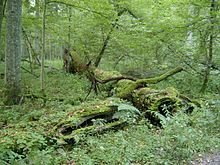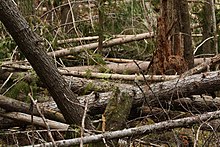Coarse woody debris

Coarse woody debris (CWD) or coarse woody habitat (CWH) refers to fallen dead trees and the remains of large branches on the ground in forests[1] and in rivers or wetlands.[2] A dead standing tree – known as a snag – provides many of the same functions as coarse woody debris. The minimum size required for woody debris to be defined as "coarse" varies by author, ranging from 2.5–20 cm (1–8 in) in diameter.[3]
Since the 1970s, forest managers worldwide have been encouraged[by whom?] to allow dead trees and woody debris to remain in woodlands, recycling nutrients trapped in the wood and providing food and habitat for a wide range of organisms, thereby improving biodiversity. The amount of coarse woody debris is considered[by whom?] an important criterion for the evaluation and restoration of temperate deciduous forest.[1] Coarse woody debris is also important in wetlands, particularly in deltas where woody debris accumulates.[2]
Sources

Coarse woody debris comes from natural tree mortality, plant pathology, insects, wildfire, logging, windthrows and floods.[citation needed]
In old growth
Benefits

Nutrient cycling
Coarse woody debris and its subsequent
Scientific studies show that coarse woody debris can be a significant contributor to
Habitat
By providing both food and
The list of organisms dependent on CWD for habitat or as a food source includes
Some plants use coarse woody debris as habitat.
Rivers and wetlands
Fallen debris and trees in streams provide shelter for fish, amphibians and mammals by modifying the flow of water and sediment.[14][15] Turtles of many species may also use coarse woody debris for basking.[16] Musk turtles may lay their eggs under logs near wetlands.[17]
Soil
Coarse woody debris, particularly on slopes, stabilizes soils by slowing downslope movement of organic matter and mineral soil. Leaves and other debris collect behind CWD, allowing for decomposition to occur. Infiltration of precipitation is improved as well. During dry weather, CWD slows evaporation of soil moisture and provides damp microhabitats for moisture-sensitive organisms.[8]
Wildfire

In fire-prone forests, coarse woody debris can be a significant fuel during a wildfire. High amounts of fuels can lead to increased fire severity and size. CWD may be managed to reduce fuel levels, particularly in forests where fire exclusion has resulted in the buildup of fuels. Reductions in CWD for fire safety should be balanced with the retention of CWD for habitat and other benefits.[18] CWD of 3 to 8 inches (7.6 to 20.3 cm) in diameter is classified as 1000-hour fuel by fire managers, referring to the amount of time needed for the moisture content in the wood to come to equilibrium with the surrounding environment.[19][20]
Regional examples

In
In the temperate deciduous forests of eastern North America, CWD provides habitat ranging from salamanders to ferns. It is an important indicator for evaluating and restoring this type of forest.[1]
In certain
In Canada,
]See also
References
- ^ JSTOR 2269480.
- ^ a b Keddy, P.A. 2010. Wetland Ecology: Principles and Conservation (2nd edition). Cambridge University Press, Cambridge, UK. 497 p, p. 225-227.
- ^ Lofroth, Eric (1998), "The dead wood cycle", in Voller, J.; Harrison, S. (eds.), Conservation biology principles for forested landscapes, Vancouver, B.C.: UBC Press, pp. 185–214, archived from the original on 2008-05-01, retrieved 2007-12-06
- JSTOR 1941147.
- .
- PMID 25536334.
- PMC 4931425.
- ^ a b c Stevens, Victoria (1997), The ecological role of coarse woody debris: an overview of the ecological importance of CWD in B.C. forests (PDF), Working Paper 30/1997, Victoria, B.C.: Research Branch, B.C. Ministry of Forests
- S2CID 20420952.
- S2CID 4424430.
- ^ a b Puplett, Dan. "Ecological Features of the Caledonian Forest - Dead Wood". Trees For Life. Archived from the original on 2014-03-01. Retrieved 2011-01-26.
- ^ JSTOR 3802978.
- .
- S2CID 67789816.
- doi:10.1071/mf99072.
- ^ Keddy, P.A. 2010. Wetland Ecology: Principles and Conservation (2nd edition). Cambridge University Press, Cambridge, UK. 497 p. Figure 8.15.
- ^ Ernst, C.H., R.W. Barbour, and J.E. Lovich. 1994. Turtles of the United States and Canada. Smithsonian Institution, Washington. p. 146.
- .
- ^ "Glossary". Fire Effects Information System. U.S. Department of Agriculture, Forest Service, Rocky Mountain Research Station, Missoula Fire Sciences Laboratory. Retrieved 5 February 2023.
- ^ "Unit 10: Fuel Moisture". National Wildfire Coordinating Group. University Corporation for Atmospheric Research. 2010. Retrieved 5 February 2023.
Further reading
- Franklin J. F., Lindenmayer D., MacMahon J. A., McKee A., Magnuson J., Perry D. A., Waide R. & Foster D. (2000). "Threads of Continuity". Conservation Biology in Practice. [Malden, MA] Blackwell Science, Inc. 1(1) pp9–16.
- Proceedings of the Symposium on the Ecology and Management of Dead Wood in Western Forests. PSW-GTR-181. William F. Laudenslayer, Jr., Patrick J. Shea, Bradley E. Valentine, C. Phillip Weatherspoon, and Thomas E. Lisle Technical Coordinators.
- Titus, B.D.; Prescott, C.E.; Maynard, D.G.; Mitchell, A.K.; Bradley, R.L.; Feller, M.C.; Koppenaa, R. (2006). "Postharvest nitrogen cycling in clearcut and alternative silvicultural systems in a montane forest in coastal British Columbia" (PDF). The Forestry Chronicle. 82 (6): 844–859. hdl:10613/2703.
